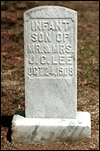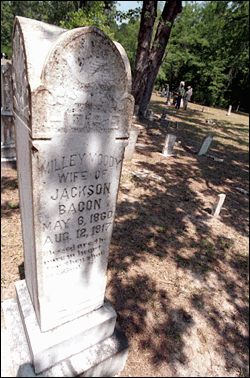

Fort Stewart's stones of history
Family members, area residents take tour of U.S. Army base's forgottten
cemeteries
Photo by Russ Bryant
A tombstone from the Moody family at the19th-century
African-American Jerusalem Church Cemetery.
By Amy Goodpaster
Strebe
(6/4/99 issue)
In 1940-41, several communities in southeast Georgia were forced to relocate when the federal government purchased 279,270 acres in Bryan, Evans, Liberty, Long and Tatnall counties, to be used as an anti-aircraft training center for the U.S. Army.
The Army took over about 1,600 properties - including churches, homes and schools - throughout the five Georgia counties.
Present day Fort Stewart is home to 15,917 soldiers and 3,381 civilian employees. There are few reminders left today of the families who lived here for hundreds of years - save for the 55 cemeteries that are tucked away amidst the forests of trees and shrubs.
The Fort Stewart Cemetery Council recently offered an all-day bus trip for area residents and family members to tour three of the 55 known cemeteries on post. According to council historian Wyman May, at one time the post engineers at Fort Stewart had the cemeteries numbered at 59. Only 27 cemeteries were listed on the deed at the time the federal government purchased the land.
At the direction of Maj. Gen. Paul E. Blackwell, commanding general of
the 24th Infantry Division (Mechanized) and Fort Stewart, the Fort Stewart
Cemetery Council was founded in 1993. The council was formed as a forum
for relatives and friends of people interred at both Fort Stewart and Hunter
Army Airfield. Because the cemeteries now rest on federal land, visitors
to the cemeteries must make a request five days in advance to the community
relations office on base, and then pick up a pass on the day of the visit
at the range control building on Highway 144.
"We've identified 2,800 burial sites on post and at Hunter," said Fort Stewart archaeologist David McKivergan, who serves as the cultural resource management specialist at Fort Stewart. "There are 55 known cemeteries on Stewart and two on Hunter, and five or six more that we haven't found yet," he said.
McKivergan has created a database which he has recorded all known information on the many tombstones and burial plots scattered on the base.
"At one time there were 20 to 25 towns and villages on post and so far we've accomplished about 25 percent of the inventory of the cemeteries at Stewart," he said.
According to McKivergan, his team of archaeologists has uncovered historic Indian burial sites near Richmond Hill that date back to the 1400s. McKivergan said a Spanish mission was said to have once been at the mouth of the Ogeechee River near Sapelo Island.
"The Indians view their burial grounds as sacred, so we do all we can to protect them and make sure that the Indian tribes have access to them," said McKivergan.
The first cemetery on the bus tour was South Salem Church Cemetery, where several members of Fred Warnell's family are buried.
"There is a lot of history here - my mother met my father in a house not far from here," said Warnell who is a trustee of the cemetery. "During the Civil War our house was spared by Gen. Sherman and most of this area was farm land at the turn of the century." he said.
Warnell has helped to raise money to help preserve the headstones and monuments, although many of them have been broken or been lost to neglect over the years.
"As I get older I find that I'm more interested in family history and wish I had listened more carefully to the stories my parents told me," said Warnell.
Col. William "Bill" Betson, garrison commander at Fort Stewart, serves as president of the Fort Stewart Cemetery Council.
"This is a good thing that we're doing today," he told the approximately 50 people who participated on the tour. "In a different life, I was a history professor. I think it's important that we preserve our heritage and take care of these things. It's the right thing to do."
The next stop on the tour was the tiny Zada Rushing Moody Cemetery where only a few grave markers are now visible. In 1991, according to May, a survey was done that counted 21 markers, but today only five or six can be seen.
"In the 1970s, I remember coming down here to find that the cemetery had been destroyed," said Warnell. "I didn't know who to call but it looked as if the stones had been vandalized."
Jerusalem Church Cemetery, a burial ground for the black community built in the 1860s, was the last cemetery featured on the tour. Hand-written tombstones scattered the area where indentions in the earth hinted at more graves that had lost their markers years ago. A picnic lunch was served alongside the cemetery, and 64-year-old Daniel Moody, a former resident, recalled memories of growing up in the area in the years before the military came.
"I was raised over the Moody Bridge and schooled in Midway and Pembroke," said Moody, who is retired from the Bryan County Board of Education.
Moody remembered walking the three miles to school and how he and others became concerned over the deteriorating state of the cemetery and decided to take action to preserve their past.
"The most important thing about the cemeteries at Fort Stewart is
that it's the only reminder the families have that they once lived here,"
said Brian Greer, an archaeologist intern at Fort Stewart who works for
McKivergan. "When I first came here almost two years ago, I was surprised
at how important it was to people - but now I understand."
To schedule a visit to the cemeteries at Fort Stewart, contact community
relations at (912) 767-5687 or (912) 767-5457.
Check out more past feature stories
Home | Contact Us | Sitemap
| FAQ | Subscribe
| Survey
(c) Copyright 1999. The Georgia Guardian. All rights
reserved.
No photo may be reproduced without our written permission.
